An Unexpected Victory: Container Stacking at the Port of Long Beach
post by Zvi · 2021-10-28T14:40:00.497Z · LW · GW · 41 commentsContents
41 comments
A miracle occurred this week. Everyone I have talked to about it, myself included, is shocked that it happened. It’s important to
- Understand what happened.
- Make sure everyone knows it happened.
- Understand how and why it happened.
- Understand how we might cause it to happen again.
- Update our models and actions.
- Ideally make this a turning point to save civilization.
That last one is a bit of a stretch goal, but I am being fully serious. If you’re not terrified that the United States is a dead player, you haven’t been paying attention – the whole reason this is a miracle, and that it shocked so many people, is that we didn’t think the system was capable of noticing a stupid, massively destructive rule with no non-trivial benefits and no defenders and scrapping it, certainly not within a day. If your model did expect it, I’m very curious to know how that is possible, and how you explain the years 2020 and 2021.
Here’s my understanding of what happened. First, the setup.
- The Ports of Los Angeles and Long Beach together are responsible for a huge percentage of shipping into the Western United States.
- There was a rule in the Port saying you could only stack shipping containers two containers high.
- This is despite the whole point of shipping containers being to stack them on top of each other so you can have a container ship.
- This rule was created, and I am not making this up, because it was decided that higher stacks were not sufficiently aesthetically pleasing.
- If you violated this rule, you lost your right to operate at the port.
- In normal times, this was annoying but not a huge deal.
- Thanks to Covid-19, there was increased demand to ship containers, creating more empty containers, and less throughput to remove those containers.
- Normally one would settle this by changing prices, but for various reasons we won’t get into price mechanisms aren’t working properly to fix supply shortages.
- Trucking companies started accumulating empty containers.
- The companies ran out of room to store the containers, because in many places they could only stack them in stacks of two, and there was no practical way to move the containers off-site.
- Trucks were forced to sit there with empty containers rather than hauling freight.
- This made all the problems worse, in a downward spiral, resulting in a standstill throughout the port.
- This was big enough to threaten the entire supply chain, and with it the economy, at least of the Western United States and potentially of the whole world via cascading problems. And similar problems are likely happening elsewhere.
- Everyone in the port, or at least a lot of them, knew this was happening.
- None of those people managed to do anything about the rule, or even get word out about the rule. No reporters wrote up news reports. No one was calling for a fix. The supply chain problems kept getting worse and mostly everyone agreed not to talk about it much and hope it would go away.
A bureaucrat insisting that stacked containers are an eyesore, causing freight to pile up because trucks are stuck sitting on empty containers, thus causing a cascading failure that destroys supply lines and brings down the economy. That certainly sounds like something that was in an early draft of Atlas Shrugged but got crossed out as too preposterous for anyone to take seriously.
Then our hero enters, and decides to coordinate and plan a persuasion campaign to get the rule changed. Here’s how I think this went down.
- He in advance arranges for various sources to give him a signal boost when the time comes, in various ways.
- He designs the message for a format that will have maximum reach and be maximally persuasive.
- This takes the form of an easy to tell physical story, that he pretends to have only discovered now.
- Since all actual public discourse now takes place on Twitter, it takes the form of a Twitter thread, which I will reproduce here in full.
It’s long, but this is a super important Twitter thread, and I strongly recommend you read the whole thing, noting that I am confident Ryan Peterson knew a lot of this before he took the boat ride:

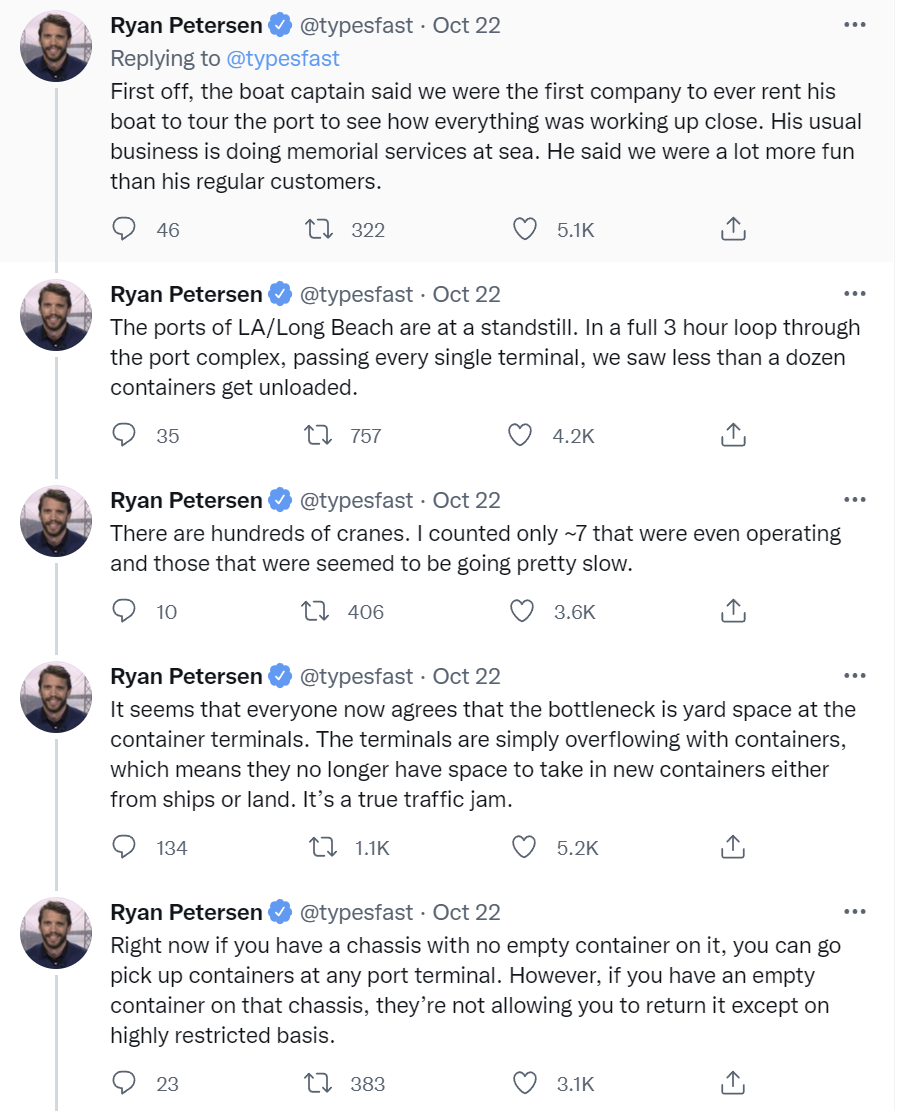
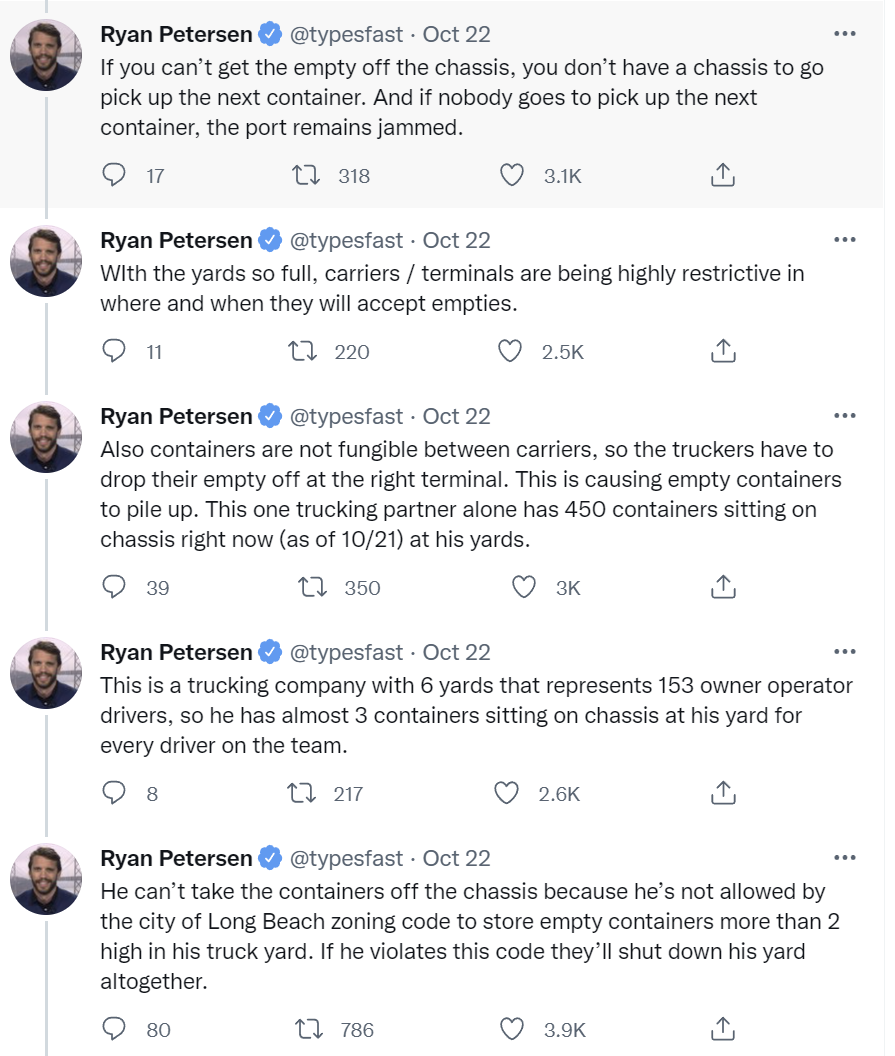
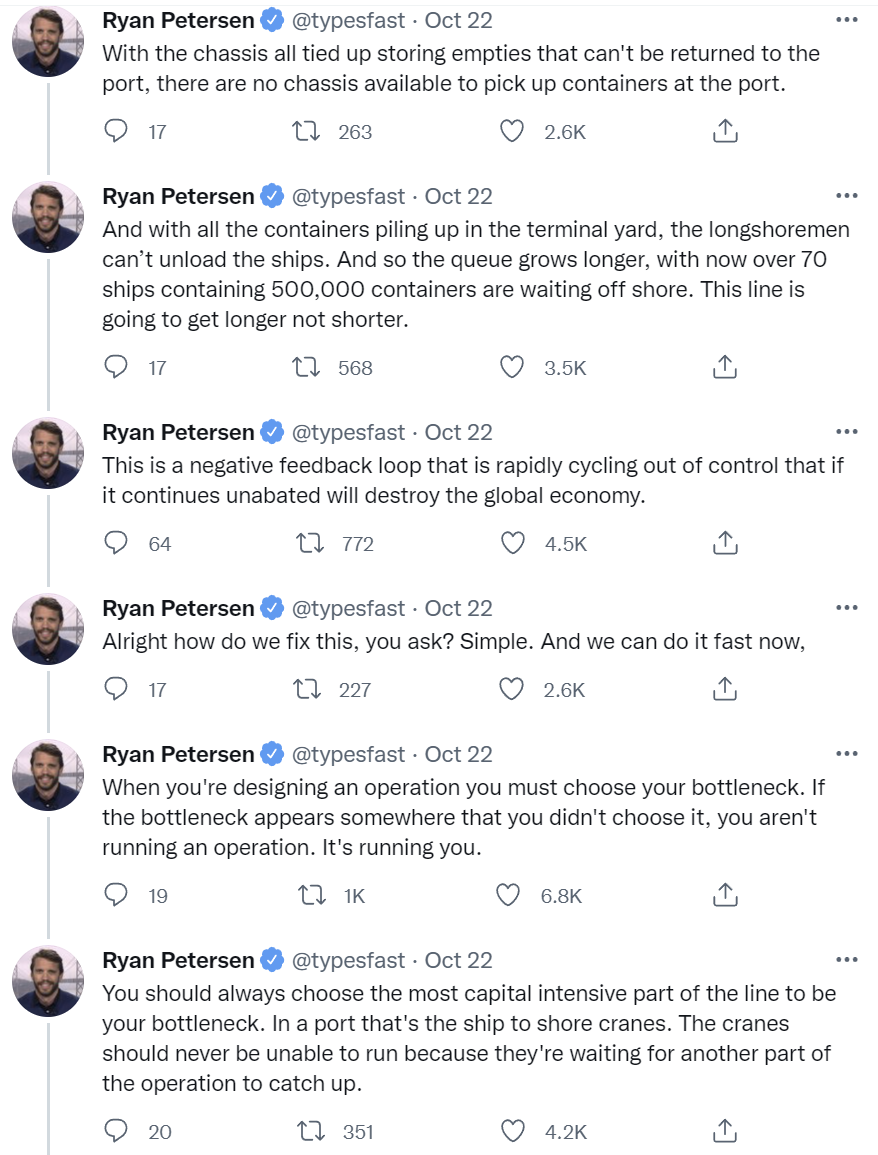
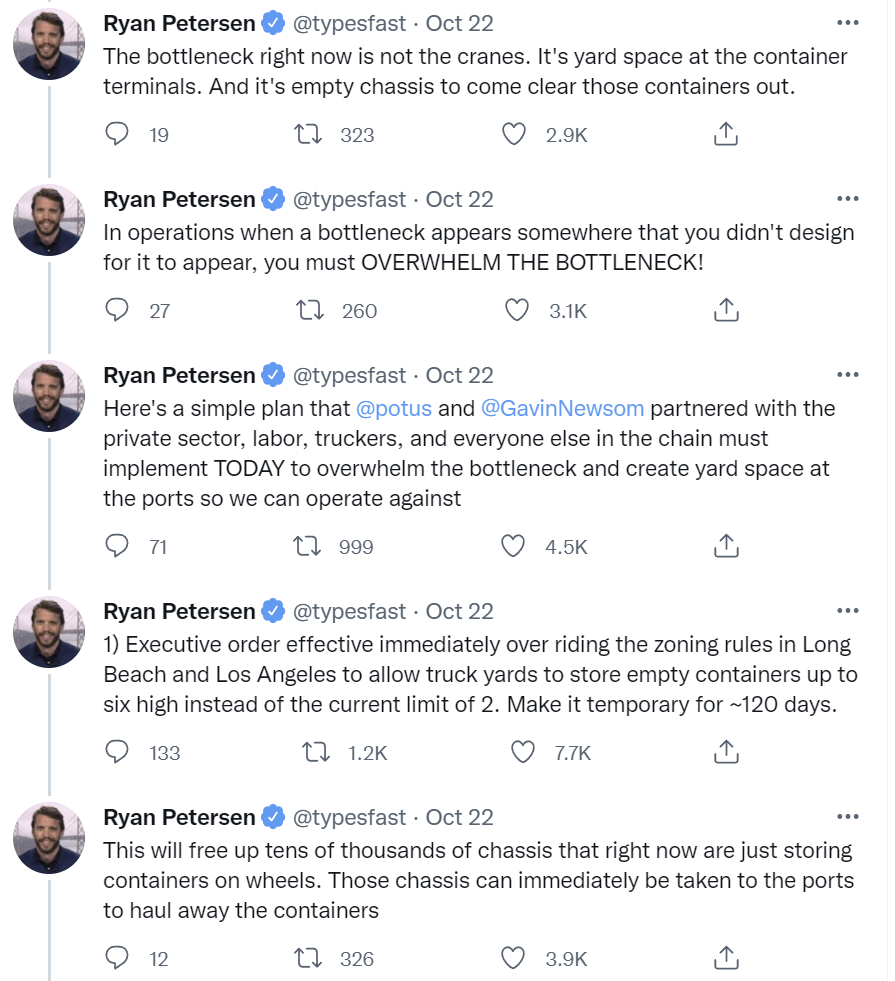
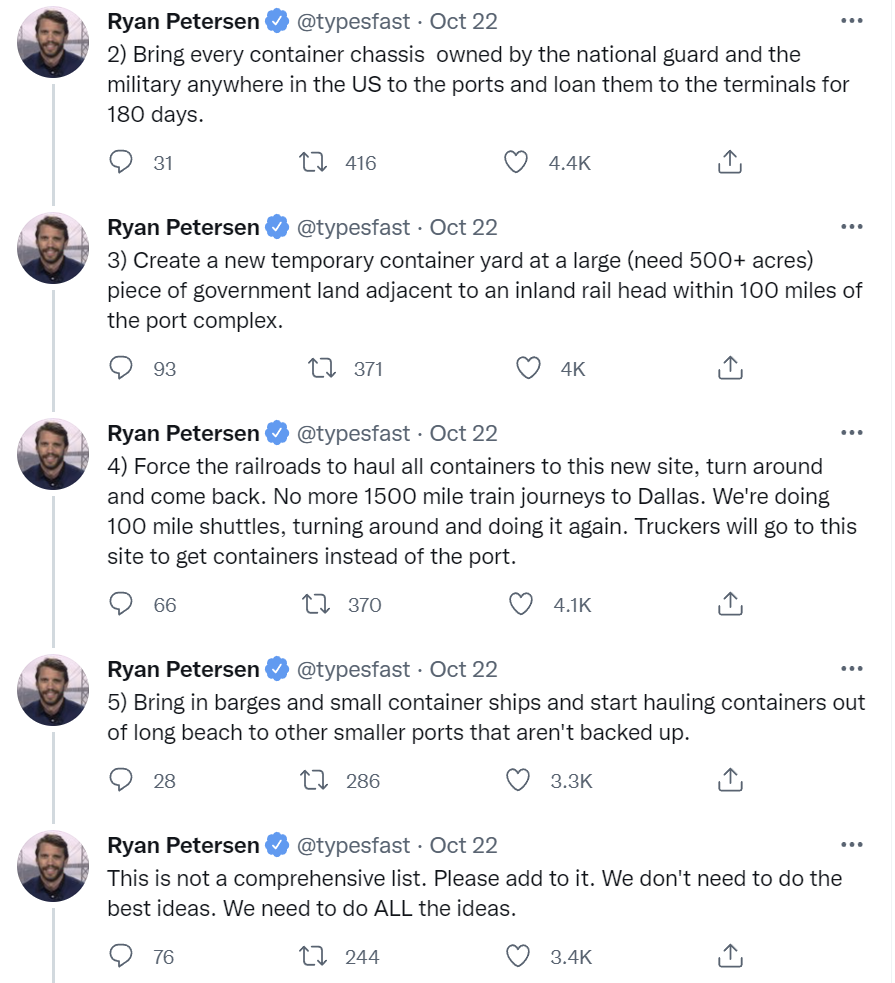
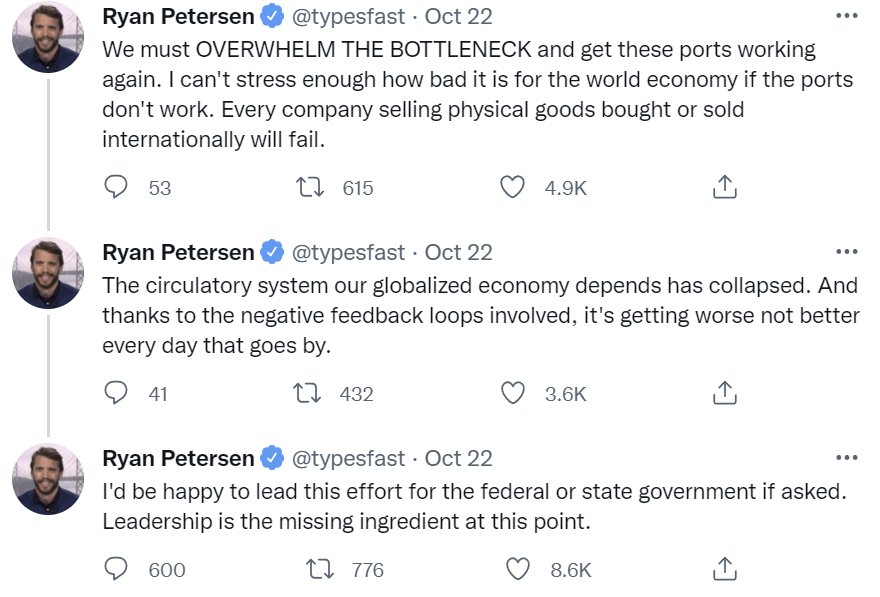
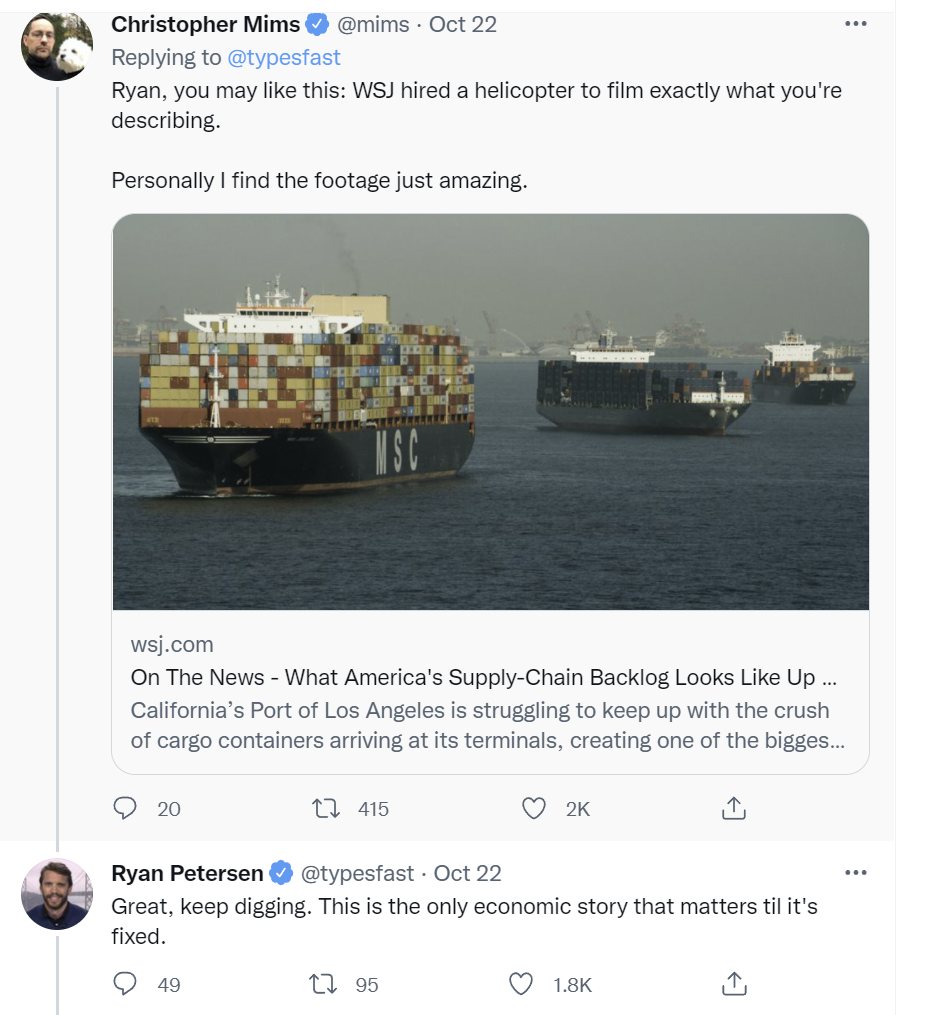
That initial tweet got 16k retweets and 33k likes, and even the others got thousands of likes as well, so this successfully got many people’s attention. It’s worth paying attention to the details here, as this was crafted in order to spread and be persuasive, and also not crafted to make people angry or to blame anyone. It’s a call to positive action. In particular, I notice these characteristics:
- Starts with a relatable physical story of a boat ride, and a friendly tone.
- Tells a (mostly manufactured) story that implies (without saying anything false) how the ride led him to figure these things out, which gives rhetorical cover to everyone else for not knowing about or talking about the problem. We can all decide to pretend this was discovered today.
- Then he invokes social consensus by saying that ‘everyone agrees‘ that the bottleneck is yard space. Which is true, as far as I can tell, everyone did agree on that. Which of course implies that everyone also knows there is a bottleneck, and that the port is backed up, and why this is happening. The hidden question of why no one is doing much about this is deflected by starting off pretending (to pretend?) that the boat ride uncovered the problem.
- Describes a clear physical problem that everyone can understand, in simple terms that everyone can understand but that don’t talk down to anyone. He makes this look easy. It is not easy, it is hard.
- Makes clear that the problem will only get worse on its own, not better, for reasons that are easy to understand.
- Makes clear the scope of the problem. Port of Long Beach effectively shuts down, we can’t ship stuff, potential global economic collapse. Not clear that it would be anything like that bad, but it could be.
- Gives a decision principle that’s simple, a good slogan and again can be understood by everyone, and that doesn’t have any obvious objections: Overwhelm the bottleneck.
- Gives a shovel-ready solution on how to begin to overwhelm the bottleneck, at zero cost, by allowing containers to stack more.
- Gives more shovel-ready solutions on top of that, so that (A) someone might go and do some of those as well, (B) someone can do the first easy thing and look like it’s some sort of compromise because they didn’t do the other things, (C) encourage others to come up with more ideas and have a conversation and actually physically think about the problem and (D) make it clear the focus is on finding solutions and solving problems, and not on which monkey gets the credit banana.
- Makes it clear solutions are non-rivalrous. We can do all of them, and should, but also do any one of them now.
- Gives a sense of urgency, and also a promise of things getting better right away. Not only can you act today, Sir, you are blameworthy tomorrow if you do not act, and you will see results and rewards tomorrow if you do act. Not only reactions to the announcements, physical results on the ground. That’s powerful stuff.
- Ends by noting that leadership is what is missing. You could be leadership and demonstrate you’re a good leader, or you can not do that and demonstrate the opposite. Whoever solves this is the leader.
The whole scenario is maximally designed to facilitate persuasion and action. Clear physical problem, clear physical solution, clear authority to implement it, no drawbacks, no losers, no cost, no associations with sensitive topics or unfortunate implications from any direction, it’s all good, you can simply do the thing and the thing is done and things are better, that’s it, no really, that’s it.
Despite this, again, no one I’ve talked to about this expected the problem to be fixed.
I didn’t see anyone posting something afterwards along the lines of ‘yes of course we lifted that restriction now that this has been pointed out.’ I certainly didn’t see anyone say ‘and of course now we should expect this to be fixed since it’s so obvious.’ I didn’t even see a sarcastic version of that. This is the most optimistic take I could find.

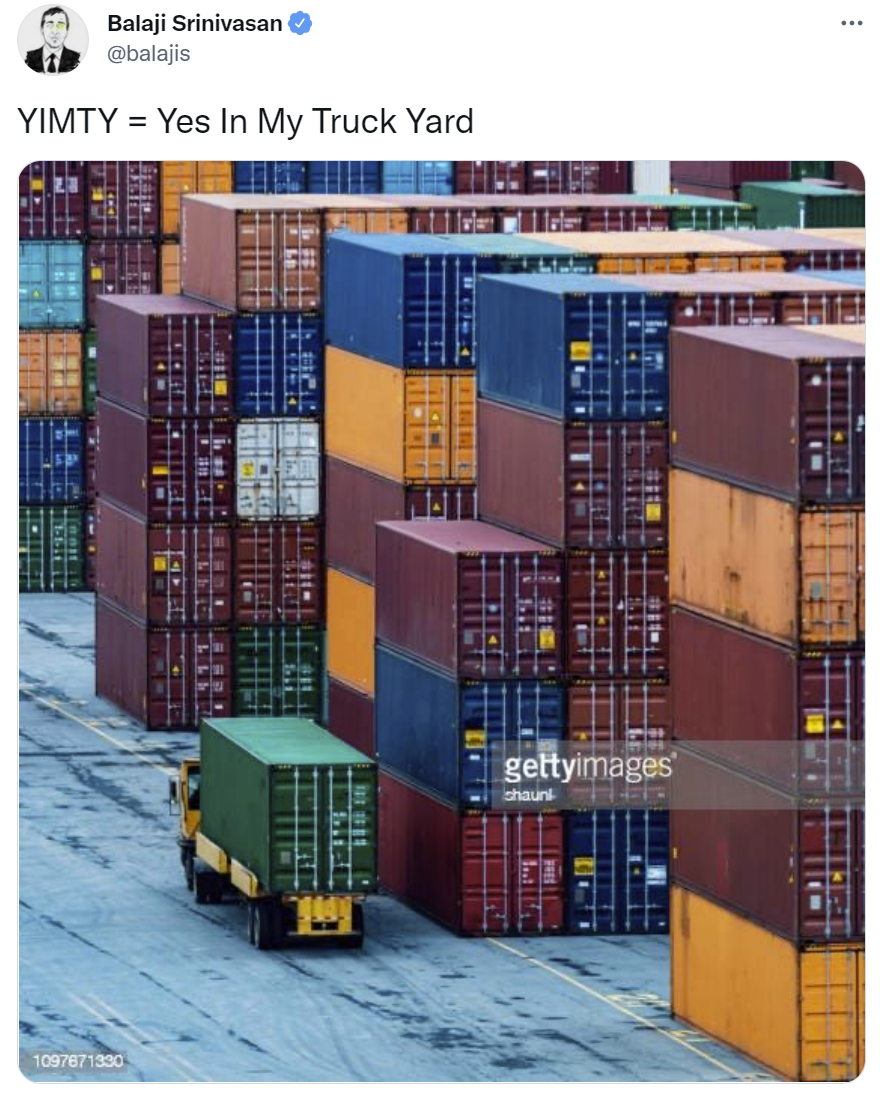
But this definitely happened. Presto.


Thus, we have a long list here of reasons why this was unusually low hanging fruit, but all these known factors combined were not sufficient to create any predictions or expectations that it would work, even with hindsight. Everyone noticed they were confused.
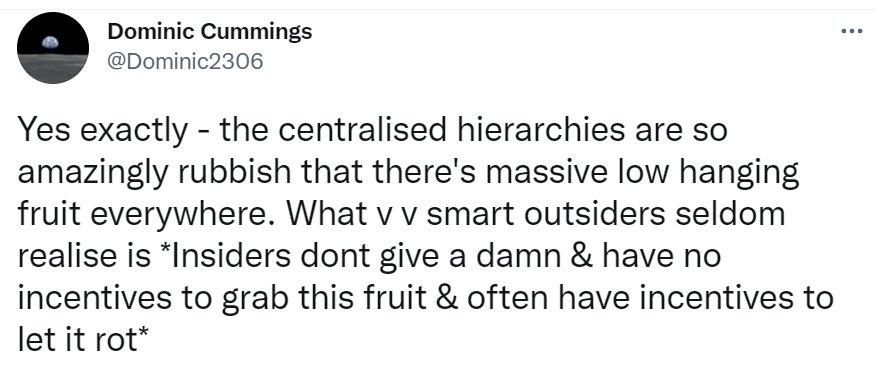
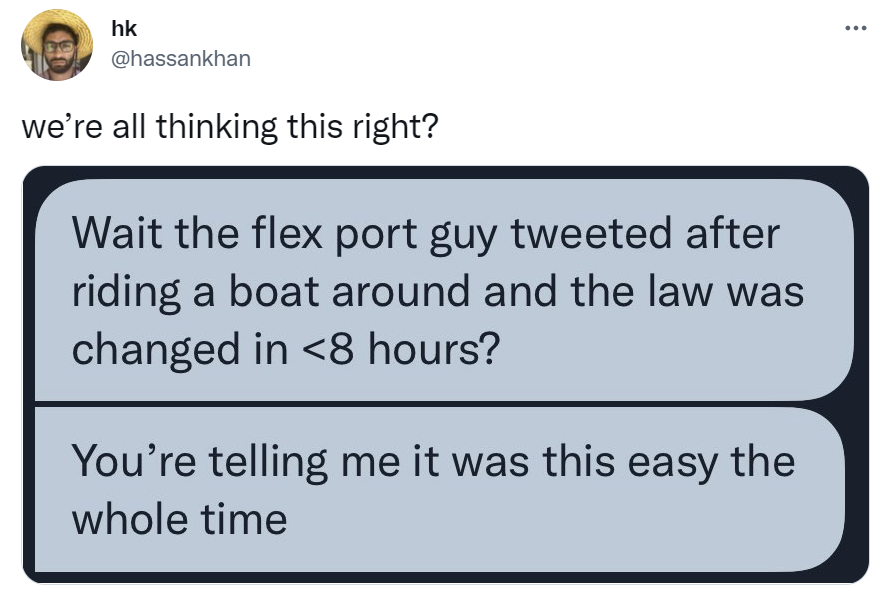
Yes. Yes, we are.
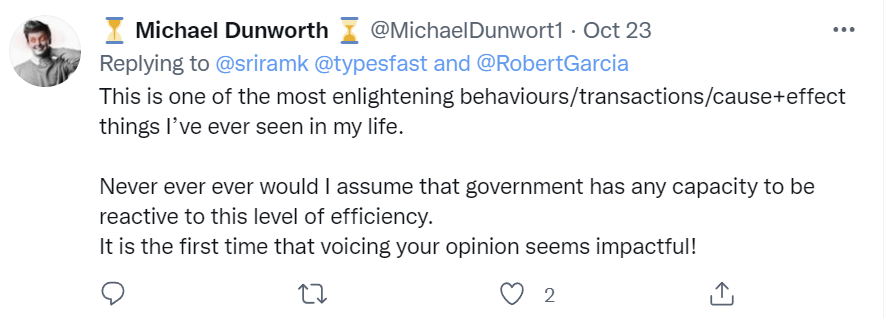
Celebrate, good times, come on:

Less than eight hours is mind-boggling efficiency. First the information has to be noticed and brought to the attention of the relevant authority, who then has to confirm that they have the authority to make the change, and do the whole Chesterson’s Fence investigation to figure out why the rule exists, and also confirm that the change is safe and write the new rule, and implement it. If you can do it much faster than this while being responsible about it, it less says that you’re super efficient and more raises once again the question of why it wasn’t done already.
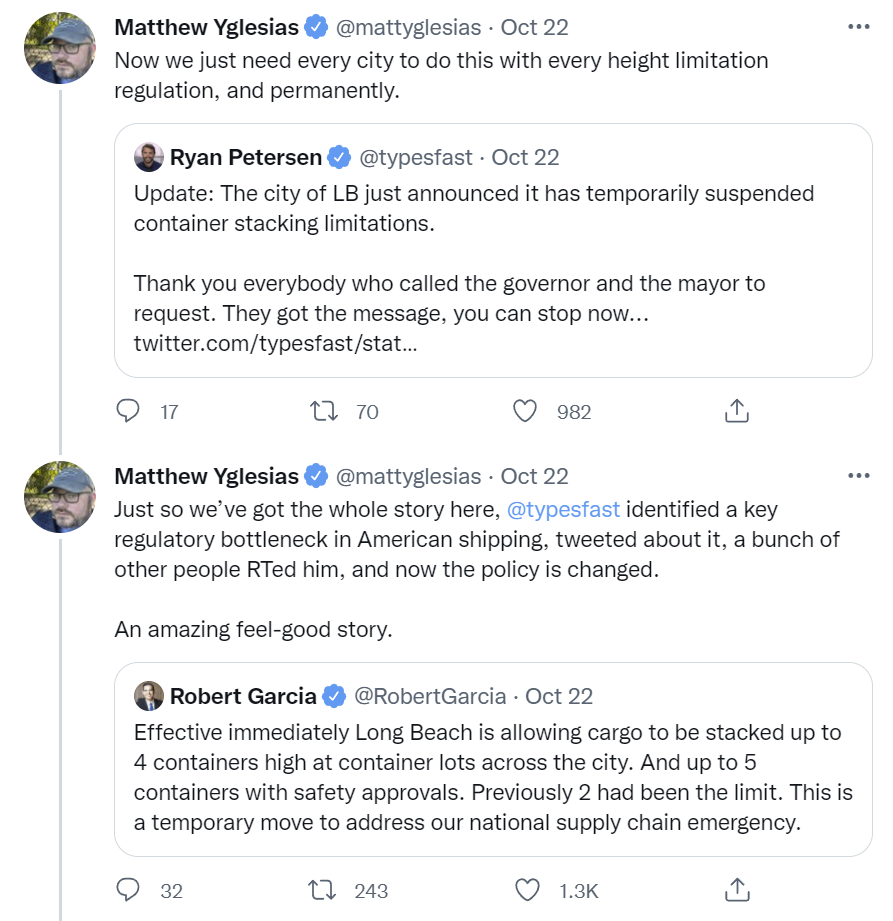

The housing metaphor is obvious and correct and apt, and in terms of benefits it’s also very low hanging fruit, but the opposition is far stronger and better motivated, so it’s not obviously the best next target once we finish fixing shipping. Even further improving shipping with similar improvements, of which there are doubtless many available, would still be surprising. All the other stuff on Ryan’s list, or other ideas that could help expand shipping? I don’t see any signs of any of that moving forward.
Even this simple change wasn’t fully implemented. Los Angeles, despite the example from Long Beach, never implemented the change. And in Long Beach, yes they allowed more stacking at existing sites, but that doesn’t mean our problems are over…


The change helped a non-zero amount, but only in Long Beach, and now it’s on to the next bottleneck, the next place action is needed and isn’t happening.
A wild idea that I haven’t heard proposed, which won’t solve our short term problems but does seem like a good idea, is how about we create a new port? If I asked you exactly where not to try and hire a bunch of people and especially not to drive a truck away from efficiently, and also to not try to expand into more space and capacity for the future, in all the Western part of the land, I’m pretty sure that my two answers would have been Los Angeles and San Francisco. Not that they are bad places for ports, but they’re where all the people and high prices and land scarcity and traffic are right now. Having all our stuff start out in those places might not be the best move. And ideally doing things elsewhere would make various barriers easier to overcome, although I fear trying to build a new thing now even in a new place would be time and cost prohibitive. But at this stage there are no bad ideas.
The focus in the short term should clearly be, all right, we made some progress on the first bottleneck. Now we need to make more progress, such as by getting Los Angeles to make the change and get faster permitting of new lots. We also should look to find the next solution for the bottleneck, and for the next bottleneck. There are some concrete suggestions on that in Ryan’s thread, but I don’t see any attempts to get further traction along those lines. Which of course is fully expected, but we didn’t expect to get the first most important thing, so who knows what is possible?
Momentum now seems like it would be incredibly valuable. If people started thinking that we could change stupid rules and do physical things, there’s treasure everywhere, and the more that kind of thing happens the more we would get ambitious enough to try things and overturn restrictions that are less obvious and where we face more resistance. The best case scenario endgame here is to start acting like live players again, and that would be quite the win.
The first step is to get the word out. Shout it from the rooftops, as it were, that we as a nation did a thing, and a thing is a thing we can do, because One Man stood up and was heard. It’s big news. The people need to know.
And yet, the people do not know. I found a Washington Post article, and it is quite good, but it wasn’t easy for me to find. If you need to share one piece that explains what happens, this is very good for that, because it is a Proper Authority and tells the real story, including that the rule was there because stacks were considered too ugly. This is an example of how one is supposed to report such things.
The only other mainstream posts I could find on a search were this from Bloomberg and this one from CBS. These are the opposite, and almost read like a cover-up. They note that the stacking limit has been eased, but says nothing about how that came to be, or why the rule was there in the first place, or how big a deal this is. They don’t tell people the news that matters most.
It’s still better than actual nothing. When I ran searches elsewhere on particular sites, after trying a general search that didn’t find much either, I got nothing. CNN has this report about how the governor issued executive orders that didn’t do anything to help, but from what I could see nothing about the stacking restriction. Fox News has nothing. As an experiment I looked at New York Times and nothing came up. That doesn’t mean I know for sure that such sources had no coverage at all, but it does mean that when I went explicitly looking for such coverage, even with site-specific searches, I still could not find it from such sources. If you know of any other coverage, especially good coverage, please share it in the comments. Given how easy it was to miss the Washington Post article, I am hopeful that there is more that I have not found.
My going theory on why the news isn’t being shared is because it is being instinctively suppressed by the implicit forces that filter out such actions from the official narratives. The whole scenario might give people the idea that we could do things because they’re helpful. It gives status to someone for being helpful. It highlights our general failure to do helpful things, and plausibly blames all our supply chain (and also plausibly all our civilizational) problems on stupid pointless rules and a failure to do obviously correct things. That’s not a good look for power, and doesn’t help anyone’s narratives, so every step of the way such things get silenced.
We need to not let this happen. People need to remember what happened here, at the Port of Long Beach.
To wrap up, my top model updates are:
- We are capable of actually acting fast and correctly when circumstances are right.
- Acting in a way that’s designed to work, and be persuasive, actually works.
- A single person can, under the right circumstances, cause such action.
- Another single person can, often, if sufficiently motivated, implement the change.
- The low hanging fruit is even lower hanging and more valuable than it looks, even after all previous adjustments for this.
- Even when such big news happens, it will be ignored, so it’s on us to spread the good word, and to find ways to do this again.
We do still have to check in all such cases, to see what was actually implemented and whether it worked. Otherwise we can’t update, and it will be too tempting to say you’re going to fix something and then do nothing.
Anyone have a good idea for a next target?
EDIT 11/12: This post has been updated to reflect new information about the extent of the impact of what happened. The section about how much the word got out has not been updated, however, as it reflects the situation at the time, despite news having gotten out somewhat more after the post was written.
If you want to continue reading my thoughts on this, I did a follow up post here.
41 comments
Comments sorted by top scores.
comment by Vitor · 2021-10-28T18:27:16.213Z · LW(p) · GW(p)
I think that there's a misunderstanding here: the rule did not apply to the Port of Long Beach, which has always stacked to reasonable heights, but to container yards in surrounding areas. On top of this I assume it applies only to small container yards (the kind owned by a trucking company that's little more than a patch of dirt to park their truck fleet), because you can't possibly operate a dedicated yard (the kind where major shipping companies keep their stock at, thousands of boxes) while stacking only two high.
This is not a nitpick, since the images of containers stacked 5 high make you imagine that storage capacity in the whole area just increased 250% overnight. I am highly confident this is not the case. The increase might only have been a few percentage points. Can't tell without more details on the local conditions.
Given this, I'd like to see some actual evidence that this is a panacea, as opposed to just a first step (still important!) in the long tower-of-hanoi logistics nightmare that clearing the bottleneck actually is.
One thing that is clear to me: untying this kind of knot almost certainly requires coordination from a higher authority than the individual companies (shipowners, truckers, exporters/importers), because those groups have goals and incentives that are at odds with each other in a situation like this.
(Source: I worked in the container shipping industry)
Replies from: Beckeck, pktechgirl, Gurkenglas↑ comment by Beckeck · 2021-10-28T21:53:16.286Z · LW(p) · GW(p)
to confirm what Vitor said, it's the logistics companies not the port that had a rules change:
"The rule change does not apply to terminals at the Port of Long Beach, which routinely stack containers up to six high. Many media reports over the weekend didn’t make a distinction between the port and inland zone, making it appear the port had new authority to increase vertical storage."
- https://www.freightwaves.com/news/city-of-long-beach-allows-logistics-companies-to-stack-containers-higher
↑ comment by Elizabeth (pktechgirl) · 2021-11-04T04:15:15.698Z · LW(p) · GW(p)
If anyone wants to double-check this without dealing with the paywall, here's the 12ft link.
↑ comment by Elizabeth (pktechgirl) · 2021-11-06T00:13:48.267Z · LW(p) · GW(p)
Note: I have offered Vitor a $200 reward for this contribution. There's a high likelihood I offer more in this area but am still operationalizing.
↑ comment by Gurkenglas · 2021-10-30T07:32:33.820Z · LW(p) · GW(p)
If these containers are empty and thus fungible, this looks to me like there's lots of space between the rows.
Replies from: Vitor↑ comment by Vitor · 2021-10-30T12:13:57.093Z · LW(p) · GW(p)
Yes, there are corridors between the stacks to allow access to the containers. And you're proposing to get rid of them and just make one huge, contiguous block of boxes, yes?
Not all those containers are empty (I'd actually expect most of them to be full if we're seeing historically high import volumes). Even if the boxes were empty, they wouldn't be fungible. They belong to different shipping companies, there are different types of containers, and even within the same type they have different ratings in terms of being foodgrade, maximum weight, etc. Sometimes they're also rented, which can affect priorization and where you want to send them.
But the biggest problem I see is that not all the empties at the port can be in the same place, because there are many ships docking at different quays, and the containers to be loaded must be pre-stacked (in a specific order) before the ship arrives, to make the operation fast and efficient.
It's an interesting idea though, I'm sure some amount of improvement is possible.
Replies from: ChristianKl↑ comment by ChristianKl · 2021-11-02T19:56:08.004Z · LW(p) · GW(p)
Not all those containers are empty (I'd actually expect most of them to be full if we're seeing historically high import volumes).
I would expect that high import volumes result in the containers being empty after unloading and then the empty containers are stuck somewhere and have to be dealt with because not enough containers get exported again?
comment by Raemon · 2021-10-28T23:17:11.105Z · LW(p) · GW(p)
One thing that sticks out as a concern for scaling this up is the attention economy. It seems like this worked, in part, by Ryan getting a bunch of people ready to signal boost is tweet, and then leveraging that to get attention from a bunch of people to call the governor or whatever (I haven't recapped the details atm).
But, that basic technique is used all the time. And the problem is that people are doing it in multiple directions, sometimes at cross purposes. It's also pretty easy to convince me that a given cause is "good", but then the issue is how it compares to all the other things I could be doing with my attention.
People's attention is a scarce resource, and most of the forces that are trying to direct my attention here are Out To Get Me. If you successfully build a new system that can scalably allocate people's attention on things, that system would be a target for people to hijack and direct to random political stuff that matters less and we're back to square one.
I'm not saying that's an insolvable problem, but it's the first thing I think of when imagining "what if we tried to scale this process to solve more broken things?"
Replies from: ryan_b, Duncan_Sabien↑ comment by ryan_b · 2021-10-29T20:28:03.574Z · LW(p) · GW(p)
This is an important dimension of the problem; a rambly explanation of my intuitions about this:
It seems to me that if the basic technique of recruiting attention is used all the time, it cannot be a distinctive feature of the success in this case; almost all forms of attention appeals fail, and I go as far as to say the very largest fail the most frequently.
My model of how attention works in problems like this is that it has a threshold, after which further attention doesn't help. This is how special interests work in politics: it doesn't matter whether something is a good idea or its overall impact, what matters is that some groups can consistently meet the minimum attention threshold on issues important to them; this puts them on equivalent footing to universal acclaim. Contrast this with advertising for a product, where every additional person who responds buys the product, so the gains are only limited by the population you can reach.
What I think did the work here is the specificity: Ryan gave the action that needed to be taken, which made success an option at all. If there were no specific prescriptions in the twitter thread, and it was all just some variation on FIX THE PORT, the result would have been nothing even with orders of magnitude more attention.
Another way to frame this is that it is an attention economy problem, but the problem we need to solve is directing the attention of the relevant authority figures to the specific actions they can take that will impact the issue at hand. This leaves the medium of twitter as one option among many for how to meet the threshold that gets the official in question to take the message seriously.
I notice that the stacking rule change is the thing that happened, which also happened to be the only thing on the list where the relevant official (the governor) was specifically identified. Stuff like establishing a temporary truckyard, loaning trucks from the military, and bossing around the railroads is much less clear cut, and so even if people take action it takes a long time to suss out how it could possibly happen. Sort of the converse of avoiding few points of failure in system resilience; we want to identify the fewest points of success, with the added proviso that we want them to be as close to the problem as possible.
The default approach is to try to get the attention of the highest-ranking person they can think of, but this runs afoul of the exact mechanism you mention where attention is precious and the higher the rank, the more fierce the competition for it, and the higher the threshold we need to reach to direct them. But I think this is a power-law distribution, which is to say that as you go down the ladder of hierarchy the attention threshold drops rapidly.
To sum up, we can mitigate the attention problem by aiming as low on the totem pole as possible, and providing as explicit an action as possible.
Replies from: AspiringRationalist↑ comment by NoSignalNoNoise (AspiringRationalist) · 2021-10-31T14:16:15.039Z · LW(p) · GW(p)
The default approach is to try to get the attention of the highest-ranking person they can think of, but this runs afoul of the exact mechanism you mention where attention is precious and the higher the rank, the more fierce the competition for it, and the higher the threshold we need to reach to direct them. But I think this is a power-law distribution, which is to say that as you go down the ladder of hierarchy the attention threshold drops rapidly.
To sum up, we can mitigate the attention problem by aiming as low on the totem pole as possible, and providing as explicit an action as possible.
I wonder if, in this context, that would have meant trying to get the attention of Transportation Secretary Buttigieg rather than President Biden. Or the mayor of Long Beach.
↑ comment by Duncan Sabien (Deactivated) (Duncan_Sabien) · 2021-10-28T23:24:24.076Z · LW(p) · GW(p)
Yeah. This reminds me of e.g. the guy who bought a billboard with his last few thousand dollars, to try to get a job. It worked! But it seems dangerously likely to spark a red queen race.
Replies from: Raemon↑ comment by Raemon · 2021-10-28T23:48:58.116Z · LW(p) · GW(p)
The "good news" is that the red queen race has been running for a long time already, so I don't necessarily think we'd make anything worse by joining in. Just, this is one particular instance of the red-queen-race-that-is-running, and should be evaluated as such.
comment by matto · 2021-10-29T12:16:11.315Z · LW(p) · GW(p)
Has anyone found a way to measure the impact the of this change? It seems it should be simple to look and see that some throughput of containers has increased, but I have had no luck in finding any kind of dashboard for this data.
The closest I've come is marinetraffic.com, which still shows quite a lot of ships around the port of Long Beach. The same site shows a simple bar graph for "congestion", but it only shows 8 weeks of data if you register a free account, making it hard to see any trends.
(There's a free trial, which I may check out during the weekend).
Replies from: ADifferentAnonymous↑ comment by ADifferentAnonymous · 2021-10-29T18:45:05.374Z · LW(p) · GW(p)
I'm curious too. FWIW this news story says "yesterday, there were 74 containerships anchored in San Pedro Bay waiting for berth space at LB or Los Angeles, down from a high of 80 last weekend," so it at least sounds like the queue is getting shorter rather than longer?
comment by DirectedEvolution (AllAmericanBreakfast) · 2021-10-28T15:34:56.167Z · LW(p) · GW(p)
Tl;dr: I love this story, but my expectation is that we're unlikely to find comparable problems to solve by a similar approach. If we can find one more roughly comparable example in, say, the next year or two, then I'll update significantly toward thinking we're missing some big wins. I'll try to remember to keep an eye out for such examples.
If your model did expect it, I’m very curious to know how that is possible, and how you explain the years 2020 and 2021.
There are two aspects to consider.
- Why didn't the rule get changed earlier?
- Why did the rule finally get changed? Alternatively, why don't the rules get changed more often?
For (1), my barely-informed guess is that before the port got backed up, the rule hadn't created any obviously significant drawbacks. Then, we did, in fact, have a failure of leadership in terms of recognizing a tractable solution to the problem.
For (2), this was a little-known rule with no defenders, tiny benefits, and (suddenly) massive, obvious drawbacks. Ryan Peterson demonstrated the leadership the situation required, and BOOM, problem solved. My guess is that this actually happens pretty often, but it usually doesn't make the news, or one of Zvi's blogposts, for precisely the same reason that the rule was able to be changed. It was a little-known rule causing a little-known problem, was changed basically in a timely fashion, and wasn't worth calling attention to. It wasn't interesting to people who don't think this is shocking, and wasn't controversial. For the same reason, this problem isn't getting much press either.
Ryan Peterson should absolutely get a credit banana for his efforts. I think this is an interesting story that we can learn from. I think our difference of opinion is that I don't anticipate that there's "treasure everywhere," in terms of lots of totally uncontroversial, obvious, low-hanging fruit waiting to be plucked by a quick change of the rules.
I think that there might be low-hanging fruit if you exclude the risk of PR problems, and allow that it would be obviously a good idea if you thought about it enough. But these are real barriers.
It might be that we can learn from Peterson, and that PR problems and framing challenges can be mitigated by a sophisticated messaging approach. So we then could say that our civilization is bottlenecked by a lack thoughtful, expert messaging laser-targeted on tractable wins.
If that's true, why? Is this hard to do well? Was Peterson just lucky? Is it rare to find high-stakes problems solvable by this approach? Is it an incentives problem, since Peterson may not be reaping much in terms of rewards relative to the value of his contribution?
Replies from: MondSemmel, edward-pascal, tvt35cwm↑ comment by MondSemmel · 2021-10-28T16:32:40.447Z · LW(p) · GW(p)
Is it an incentives problem, since Peterson may not be reaping much in terms of rewards relative to the value of his contribution?
Peterson is the CEO of a logistics company that suffered due to the pandemic, so while he can't capture all or most of the rewards here, he and his company should certainly benefit at least to some extent from getting this problem fixed. (As an analogy, Stripe's lofty mission statement of "growing the GDP of the internet" comes to mind.) Possibly the benefits even outweigh the opportunity cost of how else he could've spent this time as CEO, though not if we assume a low prior probability of success.
Ideally he'd benefit much more from this action, to incentivize repeat performances, but at least it's not necessarily a pure tragedy of the commons where each individual would have been incentivized to defect by ignoring the problem.
Replies from: Zvi↑ comment by Edward Pascal (edward-pascal) · 2021-10-29T01:06:55.244Z · LW(p) · GW(p)
"For (1), my barely-informed guess is that before the port got backed up, the rule hadn't created any obviously significant drawbacks. Then, we did, in fact, have a failure of leadership in terms of recognizing a tractable solution to the problem."
Is it possible that none of the politicians in authority had sufficient knowledge of Logistics or Operations Management and there was insufficient information flow happening to get that to some of the zoning board guys?
It seems to me, after reading a lot of Deming, this is the cause of a lot of problems: Lack of actual understanding of how a system actually works + Lack of information flow + Desire to impose rules and structures that do not take into account how a system (and mostly the people working in it) actually work.
Is it possible that fixing those things would positively impact a huge number of organizations in a practical way?
Replies from: AllAmericanBreakfast, ChristianKl↑ comment by DirectedEvolution (AllAmericanBreakfast) · 2021-10-29T02:23:23.090Z · LW(p) · GW(p)
I hear a related complaint from people working in jobs like forestry and ranching. They complain that big-city liberals dominate legislatures and impose environmental regulations with no understanding or concern for its impact on their jobs.
Replies from: AspiringRationalist↑ comment by NoSignalNoNoise (AspiringRationalist) · 2021-10-31T14:22:26.357Z · LW(p) · GW(p)
If there are specific problems with those regulations, shouldn't a legislator representing a district with a lot of forestry or ranching be able to propose a sensible solution with little opposition?
↑ comment by ChristianKl · 2021-11-02T20:04:14.843Z · LW(p) · GW(p)
Normally, that's why you have lobbyists. Big companies hire lobbyists to tell politicians about these things. When big companies don't have their own lobbyists there are often industry lobby groups that are supposed to understand problems like this and then tell the politicians to get the rule changed.
It seems like the Port of Long Beach spend $280,000 on lobbying in 2020. Maybe, that's too low and they should hire more lobbyists? Or is there some reason why this was not important enough as a policy priority for the port?
↑ comment by Greg van Paassen (tvt35cwm) · 2021-10-31T05:03:20.833Z · LW(p) · GW(p)
Probable reasons for the rule include fire safety, earthquake safety, and safety during biosecurity and drug inspections (yes, of empty containers too). Those are just off the top of my head; it's likely that there are more good reasons for such a rule. Maybe the cost calculations for these risks were done incorrectly but none of us is qualified to comment on that.
Is it worth suspending this rule temporarily in an emergency? Depends on the emergency. Permanently? Not so much. So the problem becomes "is this situation sufficiently grave that it is worth suspending rules that have solid benefits, and would such supension help very much?" It's a "balance of costs" calculation, not people being stupid. Peterson will not look so great if 5-stacking results in "The Great Fire of Long Beach".
comment by jbash · 2021-10-29T14:28:30.737Z · LW(p) · GW(p)
A wild idea that I haven’t heard proposed, which won’t solve our short term problems but does seem like a good idea, is how about we create a new port? If I asked you exactly where not to try and hire a bunch of people and especially not to drive a truck away from efficiently, and also to not try to expand into more space and capacity for the future, in all the Western part of the land, I’m pretty sure that my two answers would have been Los Angeles and San Francisco. Not that they are bad places for ports, but they’re where all the people and high prices and land scarcity and traffic are right now.
Um, I don't really know for sure about Los Angeles, but the whole city of San Francisco is there because it's geographically a really good place for a port. And I would suspect that LA is the same way. Harbors create big cities. And then huge road and rail networks get built to serve them... over decades and centuries.
Even if a big container port magically materialized in Morro Bay (and I have no idea whether that's a suitable place from the ocean's point of view), there'd be no way to move the freight to or from it. But in fact you'd have to start by creating the infrastructure to move the material to build the port itself.
I mean, if you have a magic wand, then instead of moving ports that require massive infrastructure because people have cluttered up the areas with a bunch of software businesses that could operate anywhere, why not just relocate the software businesses?
comment by nomiddlename (ipike) · 2021-10-29T06:05:38.738Z · LW(p) · GW(p)
Next target - occupational licensing
Libertarian version - remove almost all licensing. People use third party rating agencies to decide who to trust if they so desire.
Market version - remove almost all licensing requirements but require liability insurance. Insurance markets will effectively prevent unqualified candidates from practicing by pricing them out with expensive policies.
Better version of what we have now - Remove all degree requirements and test directly for competence. The test should be sufficiently thorough that passing it means you’re qualified. Every profession will have bootcamps spring up that teach you exactly what you need to know to be competent as quickly as possible.
Any of these approaches should dramatically lower the cost of most professional services.
Replies from: jacopo↑ comment by jacopo · 2021-10-29T16:29:09.011Z · LW(p) · GW(p)
The problem is, licensed people have made an investment and expect to repay it by reaping profits from the protected market. Some have borrowed money to get in and may have to file for personal bankruptcy. So they will oppose the reform by any means at their disposal, for which I don't blame them (even if it is obviously against the general interest).
Such a reform would be doable in the following cases (1) it compensates the losers in some way (2) it's so gradual that current licensed will mostly retire before it's fully implemented (3) it is decided by a political faction that has no interest in the votes of the licensed and no sympathy for their concerns, while the licensed have no "hard power" to block the reform (and this third will never be fulfilled for a blanket effort on all licenses: in practice you get a party punching down on the least powerful people in the opponent's coalition).
As you see, it's a whole other order of complication with respect to the case presented in the post...
Replies from: ipike↑ comment by nomiddlename (ipike) · 2021-10-31T06:13:22.560Z · LW(p) · GW(p)
Perhaps a targeted campaign for reform in the area of highest impact. Medicine comes to mind but that also seems like the scariest area to mess with.
I also forgot to mention that these reforms would dramatically lower the cost of education as people could choose to skip formal rigid degrees entirely.
Replies from: jacopo↑ comment by jacopo · 2021-11-01T17:42:40.311Z · LW(p) · GW(p)
I agree it would be very good, and possibly an economic no-brainer. My point is just that what is discussed in the post works for a political no-brainer, by which I mean something that no one would bother to oppose. To get what you want you need a real political campaign, or a large scale economic education campaign. Even then it's difficult, imo, unless your proposals fit one of the cases I mention above.
That said, of you are thinking of the US there is an easy proposal to be done for medicine, which is making medical school equivalent to a college degree and eliminating the requirement of having already done college before to enter (see https://slatestarcodex.com/2015/06/06/against-tulip-subsidies/, which notes it's done that way in Europe, I add it's the same for law school etc.). It's not an earth-shaking reform but it could work exactly for that reason.
Replies from: CronoDAScomment by philh · 2021-11-01T21:19:05.151Z · LW(p) · GW(p)
This rule was created, and I am not making this up, because it was decided that higher stacks were not sufficiently aesthetically pleasing.
So unless I'm missing something, the only source for this I can see here is the Washington Post article,
It turned out that the main problem wasn’t an absolute space constraint but a local zoning regulation. Long Beach prohibits companies from stacking off-loaded containers more than two high. The law is not a safety regulation but an aesthetic one. City officials decided that stacks of containers more than eight feet high were too ugly to tolerate.
and that's all it says about that. And, it wouldn't particularly surprise me if this was uncomplicatedly true, but it also wouldn't surprise me if a journalist is confused or simplifying the narrative.[1]
Googling "long beach shipping container stacking zoning" quickly...
The Maritime Executive (which I've never heard of, name sounds like they'd know what they're talking about but that doesn't mean they're trustworthy) agrees:
In an effort to help relieve the pressure, the City of Long Beach has decided to relax enforcement of a longstanding ban on high-stacked containers on private property. For years, it has forbidden stacks of more than two boxes high, an aesthetic measure intended to preserve visual sightlines in the neighborhood. That rule will not be enforced for at least the next three months, and city lots that are zoned for container storage may now stack up to four boxes high (or even five, if they get approval from the fire department).
Also, Freightwaves (same comment):
The zoning restrictions were added to the city code years ago to minimize the visual impact of industrial equipment in neighborhoods. The temporary rule change only applies to properties that are currently zoned to store containers.
(Oh, hang on - does "industrial equipment" here mean the shipping containers themselves? I suppose there's no literal reason it couldn't refer to those. But to me that word suggests, like, cranes and other things that would be moving the containers, which would be a different motivation. Speaking of which... if a storage yard has been operating for years on the assumption it won't get to stack containers more than two high, will it have / be easily able to acquire whatever it needs to handle more than that?)
Ah! The official press release agrees too:
These provisions, which have been in effect for many years, were established to address the visual impact to surrounding areas of sites with excessive storage.
That's... probably more reliable than the others? But it also doesn't cite a source, and I'd guess the person writing it wasn't there for the enactment? So like, there's still ways it could be wrong.
Still, upgraded from "sure, plausible" to "seems likely basically true".
ETA: In fact, it is simplified and wrong. WaPo says the limit is two containers because above eight feet is too ugly. Maritime Executive and Freightwaves both say it's two containers. The press report says "either two stacked containers or eight feet in height" depending on zoning.
Take a quick guess how high a shipping container is? WaPo would implicitly suggest 4'. https://en.wikipedia.org/wiki/Intermodal_container says the standard heights are 8'6" or 9'6" - presumably it's easier to vary them in height than other dimensions, but 4' would seem very short. A stack of two containers is already more than twice the eight feet that's supposedly "too ugly to tolerate". ↩︎
comment by Zvi · 2021-11-12T23:35:59.799Z · LW(p) · GW(p)
After talking to Elizabeth, and based on new information I've learned since this was posted, I've updated the OP to reflect what we've learned and avoid giving anyone the impression this change had a bigger impact than I believe that it did. The central points remain unchanged.
There were enough different changes that I'd like mods to reimport to ensure both copies reflect the same changes.
Replies from: pktechgirl, Zvi↑ comment by Elizabeth (pktechgirl) · 2021-11-19T00:57:39.124Z · LW(p) · GW(p)
I greatly appreciate the time Zvi put into talking to me and that he updated the post. For posterity, I would like to note that this covers ~30% of the change I wanted. In particular, I've gone from feeling confident Zvi's estimate of the impact of the change was that it was sufficient to clear the problem, to not knowing what he thinks the estimate is, aside from >0 (which I medium-confidence disagree with, but that's a different issue). This may or may not be because the information isn't there: it could also be that it's there but I didn't read carefully enough to derive it (and then we can debate how much effort is reasonable to expect from readers).
I don't expect further edits based on this, but it seemed like useful information to share.
↑ comment by Zvi · 2021-11-13T10:29:31.273Z · LW(p) · GW(p)
Flagging here my having-slept-on-it update policy going forward for this particular post:
- If there's a factual error anywhere, or a grammar/typo problem, I will continue to fix this particular post. If I say X happened and it didn't, I should fix it, and I should fix technical mistakes.
- If there's an impression problem, where it's felt this gives the impression that I'm claiming the change did more to solve the logjam than it did, or that we should be a certain level of excited, or something similar, nope, not going to change this post further for that, this is as far as I'm willing to go.
- If there's additional new information that seems relevant, beyond what I added this time, that's a thing to be fixed with additional posts, and if they get written I will modify this particular post to link to those new posts, but not to directly reflect new information, again unless it causes a factual error as per #1.
Flagging the update policy I have in general as well:
- If the post is timeless - as in, being used permanently as a link by myself or others on a regular basis, and continuing to get readers, or about to go into the yearly review, or something - and there's a factual error, I'll fix it.
- If the post isn't timeless - it's a weekly Covid post, or didn't become much of a thing, or whatever - then I'll fix errors within about a week, and otherwise consider myself free to not worry about it and move on, to avoid creating an undue burden.
- Anything beyond fixing factual errors in posts that don't get special attention/hits is entirely optional and requires exceptional circumstances for that to change. Typos and grammar errors and such will be fixed when it seems worth it, otherwise not.
comment by Pattern · 2021-10-28T17:07:54.171Z · LW(p) · GW(p)
4. This rule was created, and I am not making this up, because it was decided that higher stacks were not sufficiently aesthetically pleasing.
And when you see the works of old, fallen empires and wonder at their beauty, will you ask, 'did they fall because of rules to ensure aesthetic pleasure?' ('Is the modern world ugly?' 'And is it ugly because it is still alive?')
More seriously,
3. Understand how and why it happened.
seems to suggest it might be good to dig further than this:
8. Normally one would settle this by changing prices, but for various reasons we won’t get into price mechanisms aren’t working properly to fix supply shortages.
Later, though. This post has a point, and keeping it short is good for that. (While it has calls to action, like 'spread this story' it isn't just dedicated to spreading (being) the story.)
comment by Alex Flint (alexflint) · 2021-10-30T13:26:36.703Z · LW(p) · GW(p)
Thank you so much for writing this up, Zvi!
It's hard to actually be correct about the nature of the bottleneck in such a scenario, and harder still to find a workable solution. I suspect that a good part of the success of this effort was just that Ryan was actually correct about the nature of the problem and the nature of the solution. Beyond that, Ryan being head of Flexport probably helped a lot in convincing the initial signal boosters to trust his diagnosis and prescription, and then for the government folks to take the whole thing seriously. It's not just that he had a general-purpose platform, but that he had credibility in that particular industry.
comment by ryan_b · 2021-10-28T18:27:22.775Z · LW(p) · GW(p)
This strikes me as being essentially pro-social lobbying. Lobbying succeeds in a lot of cases because of things like: talking to the correct people who make the decision; easing the workload by providing a shovel-ready solution (for variants of shovel-ready that include write it this way; asking for specific things which don't obviously harm the mission or reputation of the people they lobby.
Considering the importance of the logistics issue, a natural candidate is to develop one of the other suggestions further. For example, points 3 and 4 (temporary truckyard adjascent to a rail terminal) are kind of a matched set. Off the top of my head:
- identifying suitable truckyard sites, and identifying the owners/managers who would have to give approval
- pre-work on some of the expected objections, like environmental impacts
- some considerations on costs:
- the point that stuck out to me here was switching how the trains run to short shuttle trips. Trains hate moving empty, because they don't get paid; the simple answer is to pay them; the government probably won't but other parties further back in the chain might be motivated (like the ship owners who want their ships moving; maybe Amazon and Walmart want their new stock; maybe there would be government money available but they cannot do a contract with the rails for weird procurement rule reasons)
- I feel like it might make sense to stand up a company called Emergency Logistics Incorporated or something, where the pitch is connecting the dots such that the ship owners who are hemorrhaging value are willing to pay the trains to get stuff out of the port so they can put more stuff into it. The Western US is scarcely the only place to have this problem; the whole world seems to be having issues like this.
comment by M. Y. Zuo · 2021-11-06T02:34:56.483Z · LW(p) · GW(p)
In regards to your fears: “It highlights our general failure to do helpful things, and plausibly blames all our supply chain (and also plausibly all our civilizational) problems on stupid pointless rules and a failure to do obviously correct things.”
Adam Smith may offer some enlightenment on the underlying reasons:
“The man of system, on the contrary, is apt to be very wise in his own conceit; and is often so enamoured with the supposed beauty of his own ideal plan of government, that he cannot suffer the smallest deviation from any part of it. He goes on to establish it completely and in all its parts, without any regard either to the great interests, or to the strong prejudices which may oppose it. He seems to imagine that he can arrange the different members of a great society with as much ease as the hand arranges the different pieces upon a chess-board. He does not consider that the pieces upon the chess-board have no other principle of motion besides that which the hand impresses upon them; but that, in the great chess-board of human society, every single piece has a principle of motion of its own, altogether different from that which the legislature might choose to impress upon it. If those two principles coincide and act in the same direction, the game of human society will go on easily and harmoniously, and is very likely to be happy and successful. If they are opposite or different, the game will go on miserably, and the society must be at all times in the highest degree of disorder.”
- Adam Smith
comment by ADifferentAnonymous · 2021-10-28T20:37:25.183Z · LW(p) · GW(p)
As a follow-up to point 8, it looks like the ports are going to start charging money for extended use of their scarce storage capacity: https://polb.com/port-info/news-and-press/san-pedro-bay-ports-announce-new-measure-to-clear-cargo-10-25-2021/
Seems like broadly the right call on an econ 101 level, though the fact that this was ever free is a Chesterton's Fence, $100 seems like a suspiciously round number, and I'm not sure about the differing thresholds for truck-bound vs. rail-bound containers (or thresholds at all, really).
Maybe someone who knows anything about the shipping industry can comment?
Replies from: Vitor, ADifferentAnonymous↑ comment by Vitor · 2021-10-29T09:39:33.534Z · LW(p) · GW(p)
Ports and shipping companies have complex contracts covering all kinds of services. Container storage for a few days is just part of normal operations, included in the docking fee. Longer-term storage is often included as well.
Even if your "free storage" clause has some built-in limit, it is not trivial to invoke such an exception. Keep in mind that this is an industry with few players where people know each other, and have to work together on a long-term basis. If the port tries charging, then maybe the shipping company replies "well, technically you guys aren't upholding the guaranteed turn-around times, which we have been very gracious about" etc etc.
And yes, $100 per container-day is a ludicrous number. It's meant to exert pressure, not to clear the market. It's easily more than 10x of a reasonable fee (I can't put an exact figure on this, since it's usually not charged on a per-container basis, and varies a lot by location).
↑ comment by ADifferentAnonymous · 2021-10-29T18:56:15.810Z · LW(p) · GW(p)
Further update: the port of Long Beach has made a deal with Union Pacific to haul containers to Salt Lake City that would previously have been picked up by trucks.
